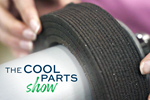Oak Ridge National Laboratory’s Project AME was undertaken to show the capabilities of different types of additive manufacturing. Prompted by the urging of the National Fluid Power Association, ORNL developed a series of functional parts for an excavator that illustrate the benefits and opportunities provided by laser powder bed fusion, large-format polymer extrusion and wire arc additive manufacturing.
The Additive Manufactured Excavator (AME) created at the ORNL Manufacturing Demonstration Facility in Tennessee, swaps three of the standard components on a Case New Holland excavator for 3D printed alternatives:
- The heat exchanger used to cool the engine. Oak Ridge simplified the manufacturing of what is conventionally a complex assembly of metal parts by 3D printing it as just one piece, using an X-line 1000 powder bed fusion machine from Concept Laser (now part of GE Additive). The new heat exchanger is made of aluminum and weighs just 13 pounds.
- The cab, which shades and protects the operator. A team of students created a new cab design making use of the geometric complexity possible with 3D printing; the part was then printed from carbon-fiber reinforced ABS using a Big Area Additive Manufacturing (BAAM) 3D printer from Cincinnati Inc. The structure was built in 5 hours.
- The stick. This hydraulic arm connects the bucket of the excavator to its boom, and enables the machine to dig, scoop and move material. Conventionally this component is an assembly of metal plates welded together, to which hydraulic lines are added. But for Project AME, the stick was built as just one piece with internal hydraulic lines using the Wolf Pack, a wire arc 3D printer developed by Wolf Robotics (now part of Lincoln Electric). The steel part was printed in five days; it is 7 feet long and weighs 400 pounds.
While future excavators likely won’t be manufactured with parts like these, the demonstrator illustrates the assembly consolidation and manufacturing advantages of 3D printing as well as its geometric possibilities. Embedded hydraulic lines could translate to conformal cooling channels in hot stamping dies or other large metal tools, for instance.
I recently had the chance to see Project AME in person and to operate the excavator. See it in action in the video above.
Related Content
-
Better, More Compact Radio Frequency Devices Through 3D Printing
3D printing technology company Fortify is applying its photopolymer process and material developed with Rogers Corporation to serve the expanding RF market.
-
Evaluating the Printability and Mechanical Properties of LFAM Regrind
A study conducted by SABIC and Local Motors identified potential for the reuse of scrap reinforced polymer from large-format additive manufacturing. As this method increases in popularity, sustainable practices for recycling excess materials is a burgeoning concern.
-
3D Printing Supports Induction Coils — and Emergency Needs
As a participant in Michigan’s Project DIAMOnD initiative, Tucker Induction Systems received a 3D printer to use any way it saw fit, provided the capacity remains available in case of emergency. Use cases and lessons learned as part of this distributed manufacturing network.


.jpg;width=70;height=70;mode=crop)










